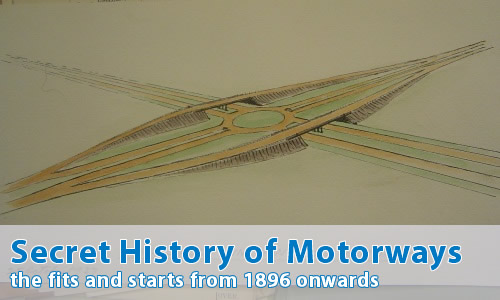Last Hurrah: 1989 - 1998
In 1989, there was some absolutely shocking news.
The Moon landings really were faked?
Clearly, but no, that's not it.
With remarkably little fanfare beforehand, a little Government document was published. Going by the snappy title of 1989/Cm 693 (or by its Sunday name of "Roads For Prosperity"), this document was a revelation. Suddenly road-building was back in fashion, and back with a bang.
Road congestion is bad for the economy. It imposes high costs on industry and other road users, by wasting time, delaying deliveries and reducing reliability. Various estimates have been made of these economic costs of road congesion. There is no way of making accurate overall estimates, but it is clear that the costs are very high.
Road congestion is also bad for the environment and bad for safety. It encourages traffic to use unsuitable roads, damaging the quality of life of people who live nearby, wasting fuel and increasing the number of accidents.
This was huge. I mean, absolutely massive.
The new programme will add over 2,700 miles of new or widened roads to the trunk road network.
Looking through the document, it's a road planners' dream. On the motorway side, it included completion of the M3, M20, M40, M49, the Second Severn Crossing, the Manchester Outer Ring Road (now M60), the A446(M) Northern Relief Road, the Western Orbital, the M62 Relief Road and some upgrades of A1 to A1(M). There were also huge amounts of motorway widening on the cards, such as the entire stretch of the M1 between M25 and M18, the entire M25, the M62 between Manchester and Huddersfield, and the M6 between Wolverhampton and the M56 and between the M1 and M42. And to top it all off, the M12 was back on - or at least the version that went between the M25 and Chelmsford!
That's ridiculous!
Absolutely, yes. Not only were that little lot (and others) added to the plan, studies were also ordered into the feasibility (or otherwise) of upgrading the entire A1 between the M25 and Gateshead to motorway, and also of upgrading the A38 between Exeter and Plymouth to motorway status.
Of course, not all of that was completely new news - the M40 for example had been on the cards for years, and construction was already underway when Roads for Prosperity was published.
The follow-up document, "Trunk Roads, England into the 1990s" continued this along, and for a while it was back to the heady days of the 1960s.
It didn't last.
What happened?
The relative economic boom of the late 1980s came to a crashing halt in the early 1990s, and suddenly the Government found itself short of a bob or two. In order to save some cash, schemes were starting to be cancelled in 1993, having come nowhere near construction.
Just to rub salt in the wounds of the road construction industry, there was a slight disagreement over a little hill in Hampshire...
Oh?
Does "Twyford Down" mean anything to you?
Sounds vaguely familiar.
It should do. There was a gap in the M3 just south of Winchester - caused mostly by the local landscape. A route for the M3 to the west of the city was caned at a Public Inquiry in the 1970s, as was a route between Winchester and St.Catherine's Hill, an Iron Age hill fort, that passed through some water meadows.
So, what was left? Well, in order to prevent problems brought up with the original route, the road was shifted to the east side of St. Catherine's Hill to Twyford Down so that the A33 Winchester Bypass could be returned to nature and the Hill become accessible once more from the city. This seemed a popular plan with the local residents, but this wasn't popular with environmental groups. The resulting protest from them (which included a permanent encampment) was both enormous, and enormously expensive to police. The price of running the M3 in a tunnel under the hill was considered to be too high by a cash-poor Government, so a great gouge was cut into the hill instead. It is said that the cost of policing the demonstration was actually more than building the bloomin' tunnel in the first place...
Bit of an own goal there, then!
Indeed so. After the publicity gained from Twyford Down, almost every major road construction project of the 1990s gained an environmental protest camp.
Whether they succeeded in their aims, or whether it was simply a useful excuse for a U-turning Government is neither here or there - the fact is that large scale road construction along new lines was now unpopular.
In 1997, the incoming Labour Government published the "New Deal for Transport", which basically junked almost every new road, and a large number of road improvements. Perhaps the most famous example of the almost indecent haste to cancel projects was in Polegate, Sussex, where one half of the bypass was cancelled, yet the other half allowed to continue - making a mockery of the entire thing, and the Government too.
It seemed almost as if the Government thinking of the 1920s had returned.

